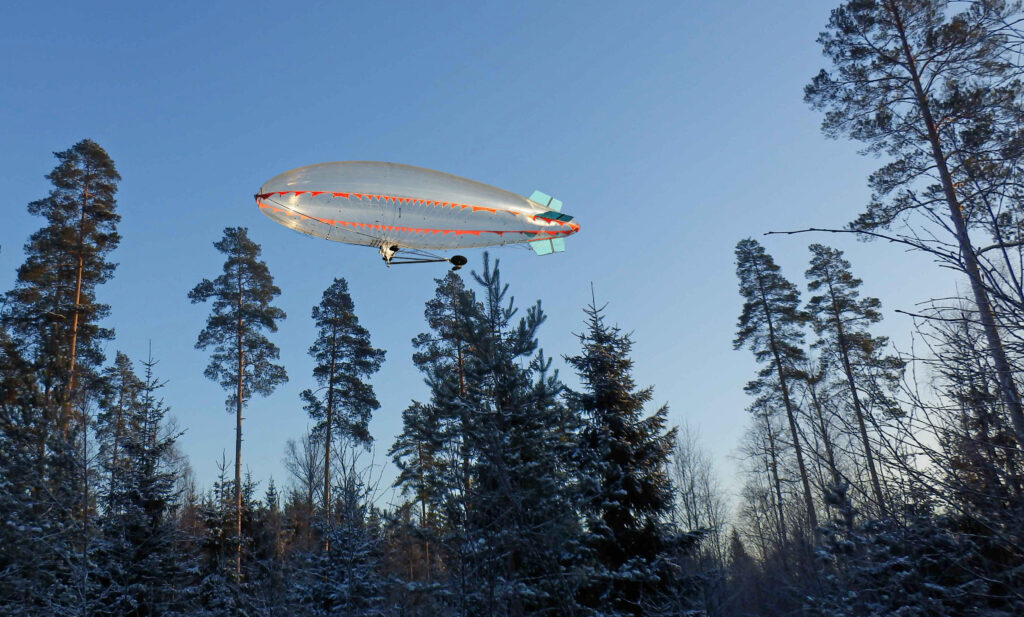Airship to tend seedling stands in smart forests of the future

In just a few years it may be possible to see airships managing seedling stands by pollarding or removing the tops of selected trees. The father of the idea is Mr. Reijo Pankka, and it won the ‘Smart Forest’s call for ideas’.
The LoggerZeppelin proposal won the ‘Smart Forest’s call for ideas’, an idea competition organized by Sitra, an innovation fund operating directly under the Finnish Parliament. The aim of the competition was to find solutions to increase the value of forest products and services and to link the internet of things with the forest industry.
Some of the pioneers of the internet of things are indeed forest machines which are continually connected to the information systems of the forest industry over the internet.
The winner of Sitra’s competition was LoggerZeppelin, an airship which tends seedling stands from above. According to the inventor, Forester Reijo Pankka, an airship could be suitable for fighting forest pests, targeted agricultural fertilization, mineral prospecting and, for example, searching for lost persons with the help of thermal imaging.
The jury for Sitra’s call for ideas evaluated LoggerZeppelin as “an innovative idea with a broad range of applications”. The members of the jury represented Sitra, the business journal Tekniikka & Talous, Nokia Growth Partners, Nokia, the Finnish Forest Industries Federation and Pöyry Management Consulting.
Pollarding could prevent carbon sink reduction
Carbon sinks in forests can be increased by managing and harvesting the forests in such a way that the trees grow denser and sturdier. On the other hand, removing the weakest trees in a thinning also reduces the biomass-binding carbon.
“This carbon sink reduction can be prevented by pollarding, which also enhances the quality of the primary trees,” says Reijo Pankka.
In pollarding, the trees are not removed completely as in the thinning of a seedling stand. Only the crown will be cut. Thus, the growth of inferior trees will slow down and the trees destined as logs will have more space.
However, the pollarded seedlings will continue the valuable carbon sequestration. They will also grow a new top, and they can be used as energy timber, for example.
Pankka has examined a Swedish study on pollarding. He considers that the method suits all tree species, as long as the height of the young trees is over 3 metres. “This meant that I had to find a solution that allows pollarding from above. That’s how the idea of an airship, the LoggerZeppelin, was born.”
Airship saves energy
Pankka’s idea of an airship as a forestry tool is based on the low energy demand of the ship. An airship can fly thanks to containing a gas lighter than air. At the beginning, the steering and operation of the LoggerZeppelin will require batteries, but, according to Pankka, the ship’s energy efficiency will improve in the future with solar panels.
Small, remotely controlled multicopters, much used in aerial photography, would also be excellent for pollarding, but as is often the case with innovations related to the internet of things, the energy capacity of the copters would be too low for the operation.
Pankka estimates that the size of the airship should be 4–10 cubic metres. The size depends on the weight of the equipment and the amount of gas needed for flying it. The saws used by a LoggerZeppelin are not particularly heavy.
“The rule of thumb is one metre. When the trees to be pollarded are cut at one metre below the highest point of the next primary tree, birch crowns cannot damage the cultivated pines, for example, by whipping. The cut-off point of the crown is two to three centimetres thick,” says Pankka.
A fully automatic forestry robot
Reijo Pankka is currently working with the airship project while completing his master’s thesis in information technology at the University of Tampere. The control and operation software of the airship is based on open source code.
The navigation utilizes positioning data from satellite technology. Laser scanning and other methods of 3D modelling help in the identification of trees.
Essential to the development of the LoggerZeppelin are the algorithms and parameters used to automate the processing, which allow robotic pollarding and help the device to identify the trees to be saved or the right pollarding height, for example.
“The forest owner decides which trees should be left and which will be pollarded. However, it is also possible to select the trees by computatio, using spatial analysis. For example, the sofware can take into account the distance between the trees, the tree species and the quality of the trees, such as straightness,” says Pankka.
At first, LoggerZeppelin will be remotely controlled: the forester can sit in his car parked at the forest edge. The ultimate aim is a fully automatic forestry robot which takes care of the pollarding and can even change its own batteries.
Kirjoita kommentti